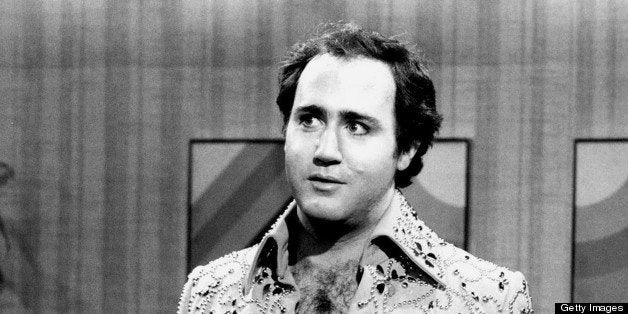
Dear D___,
I went to the book fair at the Los Angeles Museum of Contemporary Art a couple weeks ago, and in one of the many booths selling art books I found a book by David Robbins on comedy in art called Concrete Comedy: An Alternative History of Twentieth-Century Comedy. I immediately started into it because it dealt with many of the issues that I'm interested in and that are moving toward where art and consumerism and entertainment intersect. Robbins is an artist and critic who deals with comedy as his medium, and he has developed his own theory of comedy as an artistic practice that he calls concrete comedy. Concrete comedy is the comedy of behavior, reality, performance and concept; it is proposed in contradistinction to conventional comedy of stand-up, spoken gags, and wacky situations. Robbins is interested in comedy that engages with the real world, that gets its power and significance from its connection. One of his main examples of such an approach is Andy Kaufman, a man who whose work both resided in the fictional world of television and crossed over into more slippery stunts that resided somewhere between performance and real actions with real connections to the audience, outside of their role as passive recipients of information. In his wrestling extravaganza in particular Andy played the villain; he wrestled only women and made a point of verbally abusing the sex because it was part of his character and because it brought the women to full, rage-filled engagement with what he was doing. Robbins attributes much of the success of Andy's ongoing stunt to the deadpan delivery that Andy used at all times. The way that Robbins relates Andy's practice in his book makes the subject doubly interesting because he is essentially showing how a particular kind of comedy works. You would think that this would not be the most entertaining or helpful activity; Sacha Baron Cohen makes fun of such analysis of comedy in Borat, but here the intention is not to be funny, it is to conceptualize a new kind of comedy. In doing so, Robbins becomes a very compelling writer because he gives a portrait of a character who is performing very complex concepts that otherwise might be missed.
All of Kaufman's projects were dependent on his deadpan attitude and delivery; he never broke what he was doing to say, "Hey, I'm a comedian and I'm just kidding." He played the roles on stage and off stage, which caused him to be conflated with his performance personas, which in turn opened him up to particularly harsh forms of criticism. Not only were his characters sexist, he was considered a sexist asshole. I supposed this is what Andy wanted, and even though he knew he was putting on a performance that would engage with the audience in a very direct way -- he would address the audience directly and insult them for being women, or being Southern -- in order to make himself the villain of the piece. But Andy, not the character, became the villain because he never revealed that the whole thing was a planned act. This is a way to make everything an artist does part of the act. Stephen Colbert, a man who uses a persona for his work, also writes his books in his persona so that the arrogant, stupid, right-wing ass that is his character comes through in the writing. This is how Andy worked on everything, but one of the tricks is that it takes tremendous fortitude to keep up such an act when critics and fans have bought the act so thoroughly that they hate him.
Robbins plays a different and important role in this situation. He is the artist who comes after Andy has given all of his performances -- the performance that was his life -- and explicates the real significance of the work. Not that Andy needed it or sought it, but Robbins redeems Andy by revealing the plan behind the act and the deep conceptual underpinnings that supported the wacky performances. In effect, Robbins is our ambassador in the world of Andy; he goes behind the scenes and allows us to see the artist behind the performance. He shows us how to laugh with Andy. The Milos Forman film did much of this work, but, because it was a film, it couldn't get into the intricate analysis of what Kaufman was up to. In the book form, Robbins is able to give a moving portrait, a compelling argument, and a deep analysis of Andy's work. I think if there were some way for the two kinds of work to be done in conjunction or by the same person it would be incredibly powerful -- if Andy were able to write about his work after he did it. But I suppose keeping the veil in place is one of the things that gave Andy's work so much of its power, and if he were to explicate it, it still would have needed to be done with some distance. As John Cage said, don't analyze while you're making work; they're different muscles.